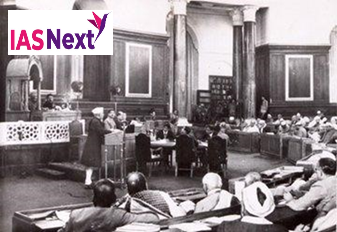CURRENT AFFAIRS
Get the most updated and recent current affair content on Padhaikaro.com
75 yrs of Constituent Assembly’s 1st sitting
- IAS NEXT, Lucknow
- 11, Dec 2021

Reference News:
The Constituent Assembly of India had held its first meeting 75 years ago on December 9, 1946.
- Distinguished people from different parts of India, different backgrounds and even differing ideologies came together with one aim- to give the people of India a worthy Constitution.
What do you need to know about the Constituent Assembly of India?
- The idea of a constituent assembly was put forward for the first time by MN Roy.
- In 1935, the Indian National Congress (INC), for the first time, officially called for a constituent assembly to frame a constitution for India.
- In 1938, J Nehru made this emphatic statement regarding the constitution- ‘The constitution of free India must be framed, without outside interference, by a constituent assembly elected on the basis of adult franchise’
- The demand for a constituent assembly was accepted for the first time by the British through their ‘August offer’ of 1940.
- Eventually, a constituent assembly was established under the provisions of the Cabinet Mission plan.
- It was constituted in 1946.
Some of the important aspects related to this are:
- Total strength of the assembly: 389.
- 296 seats for British India and 93 seats to princely states.
- 292 seats allocated for British India were to be from eleven governor’s provinces and four from Chief commissioner’s provinces.
- Seats were allocated based on proportion to their respective population.
- Seats allocated to each British province were to be decided among the three principal communities- Muslims, Sikhs and general.
- Representatives of each communities were to be elected by members of that community in the provincial legislative assembly and voting was to be by the method of proportional representation by means of single transferrable vote.
- Representatives of princely states were to be nominated by head of these princely states.
Some observations regarding the composition:
- Partly elected and partly nominated.
- Indirect election by provincial assemblies who themselves were elected on a limited franchise.
- Though an indirect mode of election, it included representatives from all sections of the society.
- Muslim league did not participate in the first meeting.
- Constituent assembly held 11 sessions over two years, 11 months and 18 days.
- Last session of the constituent assembly was held on January 24, 1950.
Constituent assembly acted as the temporary legislature until a new one was to be constituted. Some of the functions it performed at this stage were:
- Ratification of India’s membership of the commonwealth.
- It adopted the national flag.
- It adopted the national anthem.
- Adoption of National song.
- Electing Dr Rajendra Prasad as the first President of India.
Criticism of the constituent assembly:
- Not a representative body since members were not directly elected.
- It was not a sovereign body since it was established based on British order.
- It consumed unduly long time to make the constitution.
- It was dominated predominantly by congress party.
- It was dominated by lawyer-politician to a greater degree.
- It was dominated by Hindus predominantly.